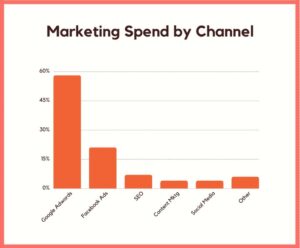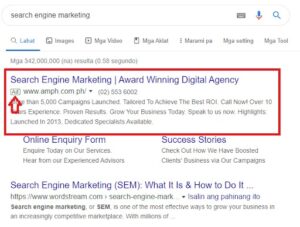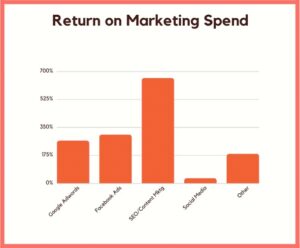Why should any business owner or entrepreneur seriously look into Search Engine Marketing (SEM) and Search Engine Optimization (SEO)?
What is the difference between SEO vs. SEM & Organic SEO services?
The use of search engines to find answers continues to increase from year to year in our digital marketing efforts. Look at the Google searches per day and see the potential:

Internet Live Stats reports that as of 2019, there are over 5.5 billion daily searches in Google with 63,000 search queries done per second.
Even compared to its popular marketing rival—social media—the latter dwarfs in comparison to usage.

Thus, both SEO and SEM should be part of any business owner’s marketing strategy.
However, the terms SEO, SEM are often confused, if not interchanged in digital marketing. Questions often arise: What is SEM? What is SEO? And more importantly, how can you utilize SEM and SEO in your marketing strategy?
Go Deeper: More Resources from our Top SEO Experts:
- What is SEO
- What does SEO Stand For
- What is Social SEO?
- The Ultimate Guide To Organic SEO
- The Top Local Search Ranking Factors
- Technical SEO and How it Affects Your Website’s Rank
- How Does SEO Work for Your Business?
- SEM vs. SEO: Tapping Your Business Potential
- White Hat SEO vs. Black Hat SEO: Are You Doing SEO Right?
- Easy Guide to Getting Local SEO to Work for Your Small Businesses
- Small Business SEO: Are You Optimizing the Right Way?
- The Importance of NLP and What It Means For SEO
- The On-page SEO Checklist
- Keyword Research Mastery: The Beginners Guide
- The Ultimate Google Algorithmic Penalty Recovery Guide
- Questions you SHOULD Ask Before Hiring an SEO Expert
- The 5 Step Beginner Guide to SEO Writing That Ranks
Defining Terms
Search Engine Marketing involves proper promotion strategies to have a strong online presence in search engines, most notably in Google, which owns 93% of the search engine market share.
Basically, there are two ways to do SEM: via organic search (aka SEO) and paid search engine marketing via ads. To put it simply, SEO and SEM go together hand in hand – and acknowledging that will help your business and knowledge in digital marketing.
Search Engine Marketing
We shall focus on advertising in search engines first for the purposes that it serves more like an “umbrella term” for which SEO is under.
How does search marketing work?
Search advertisements refer to a marketing method of placing paid advertisements in the search results page. It involves the use of pay-per-click (PPC) advertising, where business owners pay a small fee for every click on their paid advertisements.
This kind of marketing helps business owners to market their services better by reaching to more customers and achieving more online sales.
Display advertisement is another type of advertising wherein ads are displayed on relevant websites. The beauty of display ads is that they show up in websites that the reader visits. Aside from the relevancy of the websites and the ads, the ads tend to “follow” the reader. This is possible through “retargeting by pixels” which will be explained more in detail below.
What is SEM and how does it work?
Search engine marketing can be understood by classifying it as both a paid and non-paid activity. That is, it is used to lead consumers or readers to your landing pages through organic traffic and paid campaigns.
Advantages of Search Engine Marketing (SEM)
SEM serves as a “vitamin supplement” to boost your sales and traffic in your website. This is because paid advertisements can help you rank ahead of your competitors. It can also help in retargeting your potential customers.
How?
SEM techniques can have them revisit your website and purchase something in your products and/or services.
Retargeting or remarketing is an effective tool to lead your potential customers back to your website. This strategy is a “cookie-based technology” which uses “pixels” or codes. This is used so that when they search the website again, you can recapture their interest, with the potential to more conversions and higher ROI.
Optimizing your SEM tools also help your entry in Google to appear on top of the SERPs (search engine results pages). Your entry will instantly be visible to the search results page. That is, you don’t need to wait for weeks or months to appear on top.
Disadvantages of Search Engine Marketing (SEM)
SEM also has its disadvantages. For one, readers tend to ignore paid advertisements in search results.
Moreover, focusing on SEM only provides short-term results. It is a complicated and expensive process with an “expiration date.” That is, SEM strategies such as pay-per-click campaigns end when the set budget is consumed and for a particular period as well..
Finally, there is high competition for paid keywords. You will have to pay more and bid more to outrank competitors using keywords.
Google AdWords, which is mostly used as an SEM tool, also comes at a huge cost. Your ads only appear as long as you still have the budget.

As the graph shows, spending on Google AdWords costs much more than SEO/Content marketing (yes, content marketing plays a huge part of SEO!)
Who wants to keep spending on ads when there is a better way? This is why a lot of business owners want to turn to SEO.
What is SEO and how does it work?
Search Engine Optimization or SEO is composed of strategies for boosting your website to make it at the top of the Google’s search. It basically generates traffic from free natural or organic search in the search engine results pages (SERP).

If you think about it, who doesn’t want free traffic from Google? It has the lowest marketing spend and the highest Return of Investment (ROI) if you compare it with different marketing channels.
Advantages of SEO
Search engine optimization will always be the most effective way to increase both traffic and conversions over time. In fact, it generates six times more leads than SEM.
It can also have a positive long term return of investment (ROI). SEO efforts will always generate results in the SERP for your website.
Having a solid foundation of SEO also creates better credibility and authority. This is an important factor because any kind of influence should be earned.
Finally, SEO efforts also helps in pushing sales forward as well.
Disadvantages of SEO
It takes some time – sometimes months – to get results if you focus your efforts on SEO alone.
Moreover, it takes constant vigilance of your competitor’s performance.
The Components of SEO
SEO has two main parts: on page SEO and off page SEO.
On page SEO
On page SEO refers to the elements or factors that you can control in your website. Here are the most basic factors:
- Keywords. Remember the time when you searched the terms “pesto pasta recipe” or “summer hats” in Google? That is using keywords.
Your primary goal for your website is to research keywords with low competition and use them in creating your content and meta descriptions so you can optimize your products and/or services well.
- Content. Content is king when it comes to developing your on-page SEO. You must know your target readers and be able to provide them with useful and helpful information that they can use for their needs.
Your content will always depend on what you intend to offer.
- Technical Optimization. On-page SEO also relies on two technical aspects: the page loading speed and the mobile-friendliness. You don’t want your reader to wait too long while he/she waits for the website page to load, right?
For more information, you can also check out the beginner guide for writing SEO that ranks.
Off-page SEO
Off-page SEO, on the other hand, are the factors happening in your website that are not in your control. These basically include website popularity and website traffic. Google measures these two factors through unique visitors, bounce rates, Google analytics, and backlinks.
What are the similarities between SEM and SEO?
Both SEM and SEO have one goal: for your website to be more visible in search engines. Domination in the SERPs are important because studies show that only those webpages that are on the first page of search engines get the leads and potential customers.
They also rely on keyword research. This is needed to create the right and relevant content for your readers.
What are the differences between SEO and SEM?
SEM and SEO simply differ in their approach in digital marketing. That is, they differ in how they reach out to their readers or visitors.
SEO is mainly used to get organic traffic, while SEM is the bigger picture which includes search engine ad campaigns.
Which one should I choose?
Other marketers may say that SEO is a better choice compared to SEM. However, it is not really a matter of choosing which one is better.
When used wisely, both SEO and SEM can help your website rank higher in the search results page.
It may be recommended that if you are starting your own website, you can start with PPC campaigns and achieve brand recognition.
However, never lose sight of the importance of optimizing your SEO efforts.
As long as the goal is to create high-quality content and services that are worth sharing in the internet, both SEM and SEO methods can work their magic, with SEO more for long term results.
Final Thoughts
SEM is useful when you want to jumpstart your traffic and want to retarget your potential customers. However, the results are short-term and only as good as your budget will take you.
Considering both SEO and SEM, if you want long-term results with the least marketing spend, SEO is the way to go. SEO may take a long time before you see results, but with consistent effort, you will reap the rewards of your SEO efforts.



